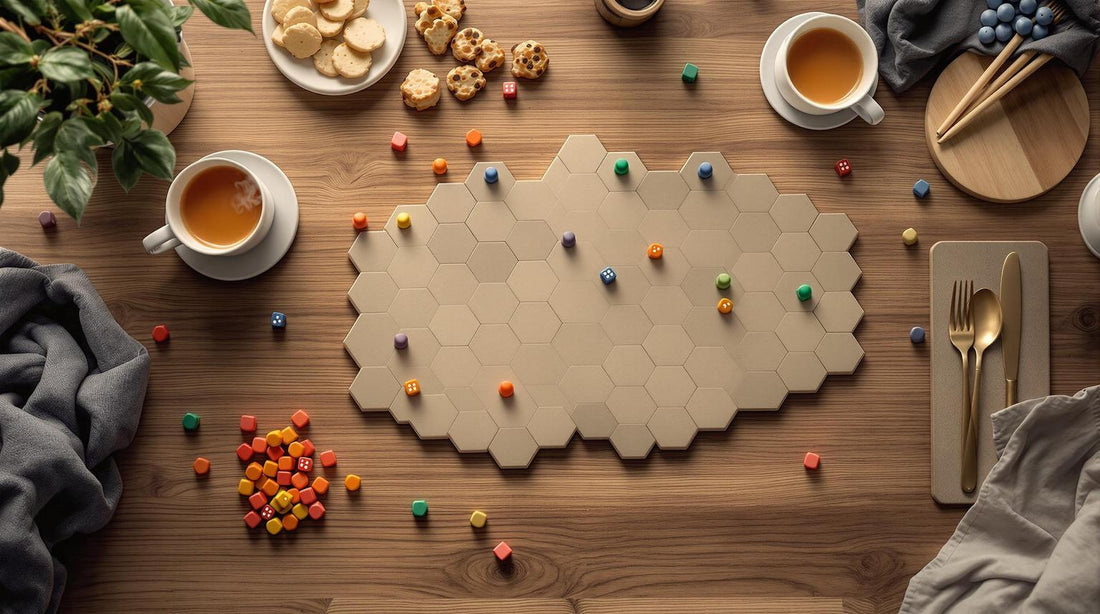Discover the Best Board Games for Every Player

5 Principles of Minimalist Board Games
Minimalist board games focus on simple mechanics, clear rules, and intentional design to create engaging experiences. Here’s a quick summary of their key principles:
- Single Main Mechanic: Games revolve around one core idea, like tile drafting in Azul or disc flipping in Othello.
- Clear Rules: Easy-to-understand rules let players jump in quickly, as seen in Blokus.
- Clean Visual Design: Uncluttered visuals, like Hive's black-and-white pieces, make gameplay intuitive.
- Limited Player Choices: Fewer options lead to deeper strategies, as in Onitama.
- Depth from Simplicity: Basic rules create complex interactions, such as Santorini's positional battles.
These principles show how simplicity can deliver meaningful depth, making minimalist games approachable yet challenging. Players value these designs for their focus on strategy and replayability without unnecessary complexity.
5 Principles of Game Design
1. Single Main Game Mechanic
Minimalist board games thrive by centering on one core mechanic, executed exceptionally well. This keeps the games easy to learn while still offering layers of strategy for players to uncover over time. Think of it like Go - its simplicity has kept players engaged for centuries.
Take Azul as an example. Its tile-drafting mechanic is simple to understand: pick tiles and place them. But the scoring system adds depth, encouraging players to think several moves ahead without bogging them down with extra rules.
Another great example is Othello, where the entire game revolves around flipping discs. The mechanic is easy to grasp, but mastering board control keeps players coming back. Modern games like Splendor (focused on gem collecting) and Tsuro (based on path placement) show how sticking to a single mechanic can create an engaging experience without unnecessary complexity.
This idea works well in educational games too. When the main mechanic aligns with learning goals, it ensures the game stays approachable while still being challenging. It’s a perfect balance: simple to pick up but rewarding to master.
2. Clear, Simple Rules
Simple, straightforward rules go hand-in-hand with a strong core mechanic - they help players jump right into the heart of the game.
Rules that are easy to understand are the backbone of minimalist board game design. The most effective games can be explained in under five minutes, allowing players to get started quickly without wading through dense rulebooks.
Take Azul, for example. Its 4-page, illustrated rulebook was a key factor in its success, helping it sell 1 million copies by 2021. Studies show that games teachable in under two minutes see 68% more replays during social gatherings.
Good rules use plain language, visual aids, and quick-reference guides to make things clear and avoid confusion.
A great example of this is Blokus. The main rule is simple: pieces of the same color must touch at the corners but not along the edges. This single rule creates dynamic, engaging gameplay without bogging players down with unnecessary complexity.
For designers, the real challenge is finding the sweet spot between simplicity and strategic depth. Simple rules don’t mean the game lacks depth - they create a framework where complexity can emerge naturally through player decisions and interactions. This allows players to focus on strategy and fun, not deciphering the rules.
3. Clean Visual Design
Clean visual design plays a key role in minimalist board games, ensuring every element is purposeful. The best games in this category use smart design choices to make the game state immediately understandable, avoiding visual clutter. This clarity complements the straightforward mechanics and simple rules mentioned earlier, creating a smooth and engaging experience.
For example, "NMBR 9" uses a black-and-white color scheme with occasional color highlights, making the number-shaped tiles easy to identify.
Here are some common design elements that contribute to this clarity:
- Limited Color Palette: Games like Hive use black-and-white insect pieces, making silhouettes instantly recognizable.
- Simple Geometric Designs: Titles such as Qwirkle feature basic shapes and colors on wooden tiles, allowing players to quickly spot and match patterns.
- Clear Information Layout: In Azul, the tiles and boards are designed with a clear hierarchy, making it easy to process game information.
Another great example is "Sagrada", which uses colorful dice as both functional game pieces and visual highlights, all within a clean and minimalist frame.
These visual design principles work hand-in-hand with the mechanics and rules, reducing mental strain while keeping the gameplay strategically engaging. Together, they create a seamless and enjoyable gaming experience.
sbb-itb-1ed942f
4. Limited Player Choices
Minimalist board games often rely on limited player choices to sharpen strategic focus. This approach emphasizes quality over quantity, encouraging players to think more deeply about each decision rather than being overwhelmed by too many options.
Take "Onitama" as an example. Players can only move one piece per turn, and their options are restricted to two move cards at a time. Similarly, "Santorini" keeps it simple: players alternate between moving and building with their workers, yet this simplicity leads to intricate gameplay. This is similar to how Azul uses straightforward actions to create complex interactions and outcomes.
Why does this work so well? Here are three key reasons:
- Reduced Cognitive Load: Fewer options mean players can focus more on the strategic implications of their choices without feeling overwhelmed.
- Clearer Decision Trees: Limited choices make it easier to predict opponents' moves and plan counterstrategies.
- Greater Impact: Every decision feels more significant because there are fewer actions to dilute its importance.
When done right, this design approach balances accessibility with strategic depth, creating games that are easy to learn but challenging to master. It’s a hallmark of minimalist game design at its best.
5. Deep Play from Basic Rules
This principle highlights how straightforward rules can lead to complex and strategic gameplay through player interaction. It’s a great example of how simplicity can lead to depth without relying on overly complicated mechanics.
Modern games are masters at creating engaging experiences by combining limited components with clear rules. Take Santorini, for instance. Its basic building mechanics evolve into complex positional battles, rewarding players who plan their moves carefully.
Game designers achieve this depth by focusing on key elements:
- Multi-purpose Components: Think of chess pieces, which can be used both offensively and defensively.
- Spatial Interactions: Consider the 3D building mechanics in Santorini.
- Shared Goals: Games like Kingdomino leverage competition over tile drafting to create tension.
Another great example is Blokus, where a simple corner-touching rule leads to endless strategic battles for territory. The interplay between piece placement and available board space results in a surprising level of complexity, all built on a straightforward foundation.
What makes this approach so effective is its ability to keep games accessible while offering long-term replayability. With just a few well-designed rules, games can create layers of strategy and creativity that keep players coming back for more. It’s proof that, when done right, constraints can inspire endless possibilities.
Simple vs. Complex Games
Simple and complex board games offer distinct experiences, each with its own strengths. By comparing the two, we can better understand how streamlined design choices can deliver engaging gameplay without overwhelming players. Minimalist games, in particular, shine by focusing on essential mechanics and uncluttered components, creating experiences that are easy to grasp yet deeply rewarding.
Take The Mind as an example. Its 100-card design (selling 1 million copies in 2019) is a stark contrast to Gloomhaven, which requires a 30-minute setup. This comparison shows how minimalist games can offer compelling gameplay with far fewer moving parts.
Here’s a quick look at how simple and complex games differ:
| Aspect | Simple Games | Complex Games |
|---|---|---|
| Rules | 1-2 pages | 10+ pages |
| Setup | 1-5 minutes | 10-30 minutes |
| Learning | 5-10 minutes | 30-60 minutes |
Games like Patchwork highlight the power of minimalist design. With just a handful of pieces, it creates a challenging spatial puzzle that keeps players engaged. This shows how carefully selected constraints can deliver rich gameplay without relying on an abundance of components.
Ultimately, minimalist designs thrive by encouraging strategic decision-making through simplicity. They prove that depth doesn’t come from the number of components, but from how players interact with straightforward rules and mechanics. This approach emphasizes creativity and strategy, even within tight boundaries.
Conclusion
The five principles show that great gameplay often comes from well-thought-out limitations rather than unnecessary complexity. Minimalist board games are thriving, with abstract strategy games experiencing a 37% increase in sales since 2019. This trend highlights how players are gravitating toward games that balance simplicity with meaningful depth.
Collections like Brain Games highlight this approach, offering titles that perfectly align with these principles. These games demonstrate how streamlined design can create fun, engaging experiences for players at any skill level.
Experts forecast a 15% rise in minimalist game titles over the next five years. As the five principles emphasize, true success in design comes not from adding more, but from intentionally leaving out what isn’t needed. This philosophy continues to influence the future of board game design, showing that strategic depth can come from thoughtful constraints.






